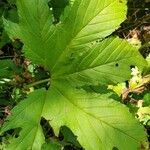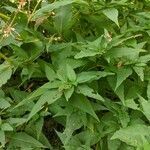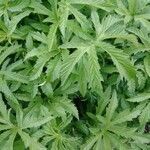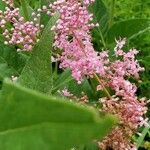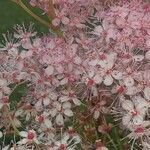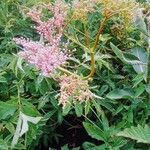Plants strongly rhizomatous, forming irregular patches, 12–25 dm. Rhizomes horizontal, thin, 2.5–3 mm wide, internodes 3–7 cm; root tubers absent. Stems glabrous. Leaves: basal 1 or 2, deciduous by flowering; stipules ovate to elliptic, 1–1.5 cm, base auriculate; lateral leaflets in 1–5 pairs, remote, ovate to elliptic, to 9 cm, ?palmately 2–3-lobed, lobes lanceolate?, margins serrate or doubly serrate; terminal leaflets round, 10–15 cm diam., palmately 7–9-lobed, lobes oblanceolate to lanceolate, margins doubly serrate, apex acute to acuminate, surfaces hairy at least on veins, ?hairs appressed, straight, short, 0.5 mm?, or adaxial glabrous. Inflorescences 100+-flowered; branches and pedicels glabrous. Flowers: hypanthium slightly concave; sepals (4–)5(–6), purplish, spatulate to triangular, 1–3 mm, margins without midrib, abaxially glabrous, adaxially finely appressed-hairy or glabrous; petals (4–)5(–6), pink to purple, orbiculate, 2.5–7 mm, claws distinct, short, base narrow, margins unevenly toothed; stamens pink to purplish, about equal to or longer than petals. Achenes 3–7, flattened, oblanceolate, straight, 8–14 mm, glabrous; stipes 0.5–1.5 mm; styles 1–2 mm.
More
Pls glabrous, 1–2 m; terminal lfl reniform in outline, to 2 dm wide, deeply cleft into 5–9 lanceolate or oblong, serrate segments; lateral lfls 2–5 pairs, sessile, to 1 dm, shallowly to deeply 3–5-lobed; infl 1–2 dm wide; sep broadly round-ovate; pet mostly 5, rich pink, 2–4 mm; frs glabrous, erect, oblong, 6–8 mm. Low woods and wet prairies or meadows; N.Y. to Minn., s. to N.C. and Ky., and sometimes escaped from cult. elsewhere. June, July.
